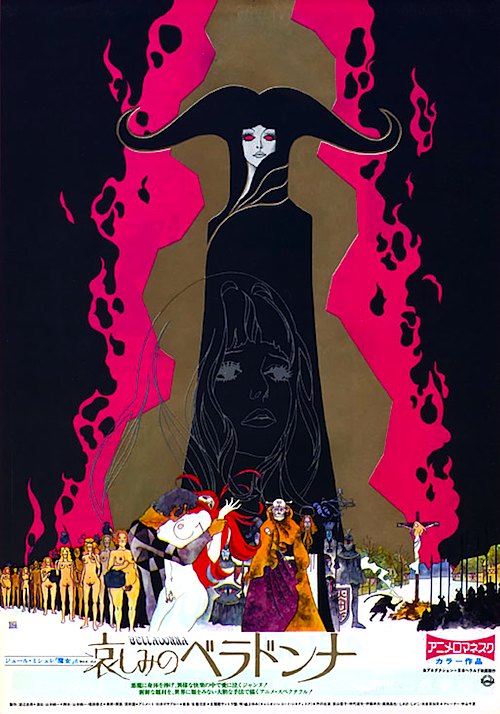By Joe Bendel. Think of it as something like Bernard Christensen’s Häxan, but in color and with even more sex. While the notorious Danish silent was based on the Fifteenth Century Malleus Maleficarum, the third of Osamu Tezuka’s animated features for adults was inspired by Jules Michelet’s Nineteenth Century study Satanism and Witchcraft. The practice of the dark arts is largely a product of class and gender exploitation in the brand new 4K restoration of Eiichi Yamamoto’s 1973 cult classic Belladonna of Sadness, which screens as part of the 2015 Japan Cuts Festival of New Japanese Film.
 French peasants Jean and Jeanne love each other deeply and truly, but unfortunately their marriage requires a sacrifice to their lord. Tragically, he claims his feudal deflowering right of jus primae noctis, at which point he turns the ravaged Jeanne over to his lecherous court. Initially, Jean tries to comfort her, but henceforth they can never truly be happy together. Sensing her pain and anger, the imp-like Satan approaches Jeanne tempting her with power and exciting her lust. She slowly yields to him, inch by metaphysical inch, amassing influence in the village to become a serious rival to the lord, especially while he is away fighting a fruitless war. Naturally, this does not sit well with her ladyship or the parish priest.
French peasants Jean and Jeanne love each other deeply and truly, but unfortunately their marriage requires a sacrifice to their lord. Tragically, he claims his feudal deflowering right of jus primae noctis, at which point he turns the ravaged Jeanne over to his lecherous court. Initially, Jean tries to comfort her, but henceforth they can never truly be happy together. Sensing her pain and anger, the imp-like Satan approaches Jeanne tempting her with power and exciting her lust. She slowly yields to him, inch by metaphysical inch, amassing influence in the village to become a serious rival to the lord, especially while he is away fighting a fruitless war. Naturally, this does not sit well with her ladyship or the parish priest.
Even though it is animated, Belladonna is absolutely, positively not for children—not even the particularly mature and precocious. Yamamoto’s film is rife with images of sex and violence that often bleed into each other. However, the animation is extraordinarily striking, often looking like a cross between Alphonse Mucha and Gahan Wilson. For long stretches, the pictures do not even move, per se. Rather, the camera pans over the baroquely detailed paintings.
Frankly, it is rather baffling that Belladonna never caught on more widely in its day. The trippy visuals and open invitation to identify with and even support Jeanne’s self-damnation seem pitch perfect for the indulgent 1970s. As a bonus, legendary Kurosawa and Kobayashi regular Tatsuya Nakadai memorably gives voice to the puckish Satan.
In many ways, Belladonna is a startling accomplishment in animation. It really feels like it taps directly into the ancient grievances of women who were driven to witchcraft for the sake of solidarity and resistance, which is rather unsettling. There is an eerie subconscious familiarity to Belladonna, even though it is a wholly original work. Highly recommended for mature animation connoisseurs, the newly restored Belladonna of Sadness screens this Friday (7/10) at the Japan Society, as a classic rediscovery of this year’s Japan Cuts.
LFM GRADE: A
Posted on July 10th, 2015 at 4:48pm.